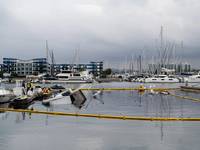Yacht Designers Set for SCIBS
Sanctuary Cove International Boat Show (SCIBS) will welcome several talented yacht designers among its 300 exhibitors this year, each displaying cutting-edge technology and concepts they describe as “game changers”.
Based in the Australian Marine Pavilion, which will house innovative Australian-made products, superyacht companies and destination marketers, Albert Sedlmayer will have on show the plans and presentation to support his concept of the SPECTRUM 52, a sleek and unique 52-metre catamaran ideal for world cruising that, once constructed, would be the biggest cat ever made.
As Albert explains “SPECTRUM 52 is an aluminium sailing catamaran superyacht that will sail or power at 20 knots with a range of 2,600 nautical miles or nearly double that at 16 knots. Of course the range under sail is unlimited!
“The slender, low-resistance hulls maintain efficient speed while generous overall beam provides abundant living space and stability, with ample power to carry sail.”
And an impressive sail it is, coming in at a total of 1,700 square metres.
With accommodation for 10 guests and up to eight crew and with a beam of 22.2-metres, SPECTRUM 52 has been designed to provide an unprecedented catamaran sailing experience, combined with ultimate superyacht lifestyle, and space only a catamaran can deliver.
Albert says he is looking forward to exhibiting at SCIBS, an event he has attended previously as a visitor, but which as an exhibitor he hopes to leverage interest from its broad demographic of consumer, trade and international visitors.
“It should be a great place to raise my profile, launch the SPECTRUM 52 Class Design, which is at a stage that it could go into construction very shortly after commissioning. I will have an AV display showing slides of various renderings of the ship and a catalogue of preliminary drawings.”
The newest luxury motoryacht brand on the Australian market will be on show at SCIBS, two months before the first hull is on display at the Sydney International Boat Show.
Currently under wraps on the Gold Coast, the Elandra 53 sports yacht – Elandra meaning “Home by the Sea” – has been a collaboration among Grant Senior, Luke Durman, Tom Barry-Cotter and Bill Cranston.
Elandra General Manager and hull designer, Grant Senior is looking forward to previewing the new yacht to a discerning market at SCIBS.
"It has been an exciting collaboration across our team," he says. "Everyone has contributed ideas. Together, the design and construction deliver a range of significant benefits. The convex shape and width at the transom help with stability and mean we can carry the weight of engine options, jet tenders, water-makers and other equipment around the stern area without affecting performance.
"Carrying the beam to the transom provides a massive cockpit entertaining area as well as large volume below the deck for our tender garage as well as the cavernous lazarettes for stowing gear.
"Our system will also ensure a quieter and softer ride and a more durable hull than standard fibreglass constructions," he says. "Elandra yachts will be particularly stable and secure in heavy sea conditions. This is why we are able to offer a full 10-year structural hull warranty, double that of competitor builders. We also provide a four-year limited stem-to-stern warranty."
Contemporary styling, wide beam and large areas for entertaining, relaxing and accommodation, plus excellent fuel economy and stability for long range cruising means those looking for a boat can satisfy the head and heart.
Also on show in the Australian Marine Pavilion is a device that is not a boat, but could prove highly useful for marine-oriented industries. The wave-powered drone, known as “Reef Ranger” is the brain-child of Matthew Morgan, who came up with the prototype with the objective of offering a drone that could operate in the ocean with a variety of duties.
“It can be used to survey in open oceans, monitor salinity and temperature changes, CO2 levels, chemicals, weather conditions, ocean currents and many other applications,” he says.
Some of those potential applications include scientific research, stock assessment for fisheries, mammal monitoring, as well as commercial, security and defence uses such as offshore asset protection and servicing existing marine markers or buoys.
“The Reef Ranger could potentially replace ships buoys, as it has a ‘station holding’ function and its persistence application means it can be deployed for months or even years, relying solely on wave energy.”
For Matthew, attending SCIBS represents the opportunity to connect with an international audience, the professional and trade market that would recognise the Reef Ranger as a useful device in their industries.





